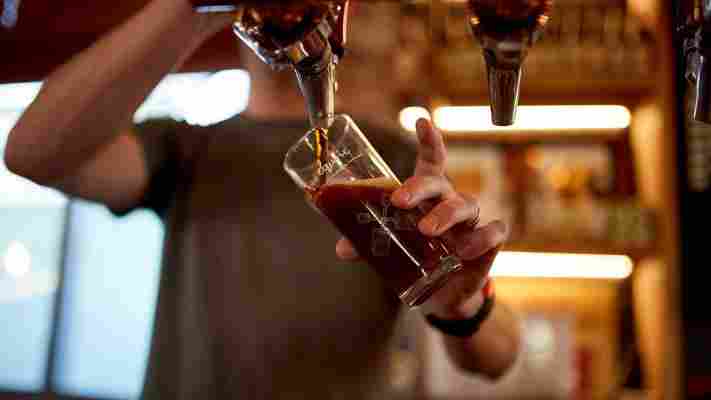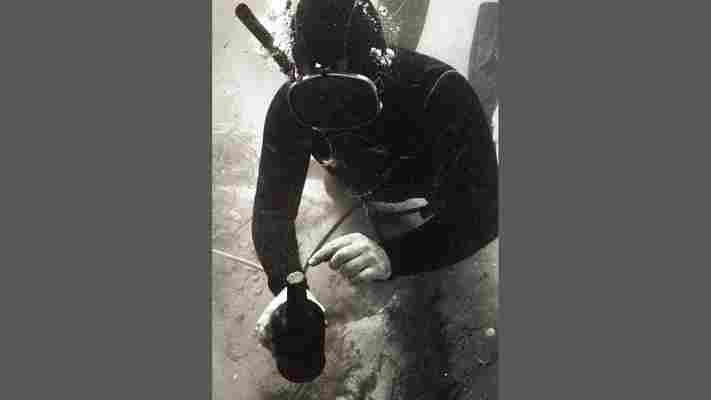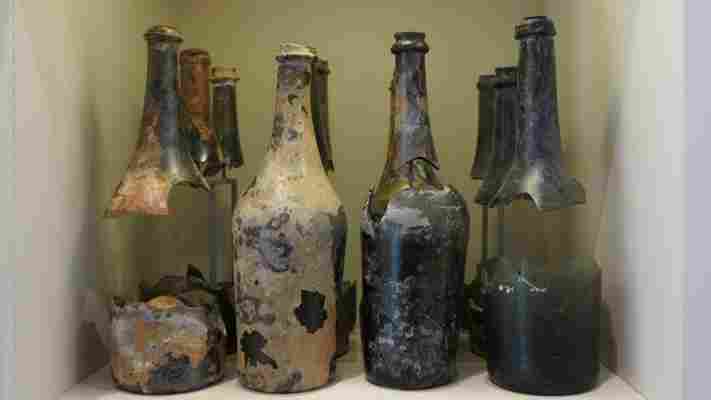Australia is a nation built on beer. When Port Jackson, the site around which the city of Sydney sprang up, was settled in the late 1700s, the people there were hungry not just for food, but for a steady supply of ale and other types of liquor.

In 1796, the colonial trading firm Campbell and Clark commissioned the ship Sydney Cove to sail from Calcutta in India to Port Jackson, with a cargo of provisions including ales, wines and spirits as well as essential supplies such as grain and timber. The ship never reached its destination.
Foundering off Tasmania’s treacherous north coast near the aptly named Preservation Island, the Sydney Cove ground to a halt on a sandbank and sank slowly while the crew salvaged what they could. Artefacts from excavations of the survivors’ camp indicate that this included some of the beer.
Two hundred and twenty years later, I was standing below the ship’s towering rudder, the centrepiece of the Sydney Cove shipwreck exhibition at the Queen Victoria Museum & Art Gallery in Launceston, Tasmania. The ship may have failed to steer its course to Sydney, but the remaining beer survived for around 200 years on the icy seabed. In the 1990s it was recovered from the wreck during excavations led by Mike Nash, a marine archaeologist with the Australian Historic Shipwrecks Team, and sent to the museum in Launceston for preservation. And now the beer is back, renewed and re-brewed courtesy of a partnership between the museum and Australian brewing company James Squire.

Archaeologists recovered bottles of beer from the Sydney Cove, which wrecked off the coast of Tasmania (Credit: Mike Nash, Tasmanian Parks and Wildlife Service/QVMAG collection)
You may also be interested in: • The libation made 20m below Paris • A hidden world 30m below Budapest • The town that throws wine in the sea
Museum conservator David Thurrowgood came upon 26 bottles in the collection of artefacts from the wreck in a storage room in 2015. That’s where I met him, behind the scenes of the museum, where the historical collection, fragments of the ship and its cargo, is housed on shelves in a bright white, state-of-the-art facility.
Tenderly, Thurrowgood lifted a bottle from a small box. Its surface was opaque and muddied, the glass hand blown more than 200 years ago. The knobbly and degraded cork was still intact. And inside was the original brew.
The scientist in Thurrowgood – who holds a double degree in journalism and chemistry – realised upon first inspecting the bottles that they represented a unique example from the diet of everyday people from a time before the industrial revolution. And if the yeast was still alive, it could still be brewed from.
Thurrowgood also knew that concocting beer from a 220-year-old yeast was likely to grab headlines across the world. With museum funding on a steady decline for the past decade, drawing the public eye and reimagining collections is vital, he said.

The beer bottles are part of the Queen Victoria Museum & Art Gallery’s Sydney Cove shipwreck exhibition (Credit: Queen Victoria Museum & Art Gallery)
As we sat in his office, Thurrowgood reached for a more modern-day, clear glass bottle from the bottom shelf of a bookcase. The liquid inside was a familiar golden colour. Suddenly he gave it a shake, and the contents swirled with sediment. It was the original sample he took from the wreck’s beer, which he cultured in test batches in the museum’s conservation department, proving the yeast was still viable.
From yeast comes bread, too, of course. Guiding me through the warren of workshops in the museum’s conservation department, he stopped before a chest freezer, lifted its lid and retrieved three loaves made using the yeast from the wreck. He handed me a loaf. It was heavy and crusty with a faint, floury fragrance.
It was thirsty for life
With the museum team having proven the historical yeast still lived, a partnership with the Australian Wine Research Institute ensued. Their national laboratory in Adelaide helped to isolate the yeast for brewing in commercial quantity.
The project scaled up further when James Squire came on board to brew beer from the yeast in commercial quantities, with the ultimate aim of releasing it for sale. Head brewer Haydon Morgan was set the task of brewing from the centuries-old yeast, and found it to have properties quite different from its modern-day commercial counterparts. During the brewing process, the shipwreck yeast rapidly consumed all the available sugar in the ferment and produced a dry beer. Even after 200 years on the seabed and months in laboratory bottles, it revived quickly and could still be brewed, whereas a contemporary commercial yeast would be dead within weeks. It was, as Morgan said, “thirsty for life”.
Queen Victoria Museum curator David Thurrowgood (left) discovered that the yeast in the beer bottles could be used for brewing (Credit: Scott Gelston)
Morgan’s team trialled recipes based on the types of beer brewed in 1797, the year the Sydney Cove foundered. According to letters and historical documents from the time, these were darker ales such as Porter, IPAs and so-called ‘small ales’, which were lower in alcohol by volume.
It was important to respect the yeast’s history and keep its integrity, while producing a beer that modern consumers would enjoy, Morgan said. They decided that the Porter style would work best, and created a beer with a rich, smooth taste and hints of blackcurrant and spices.
After trialling small 120-litre ferments, they scaled up to 5,000-litre brews, whereupon the yeast threw a slightly different result, a beer with a different flavour profile from the trial brew, earning itself the tag of ‘temperamental’ from the brewing team.
The yeast and the beer it produced was felt to be a good fit within the James Squire stable. The eponymous James Squire was a bit of a rogue; an early convict settler who got his ticket of leave and was set free, going on to build a beer empire that is the antecedent of the modern-day company.
The Queen Victoria Museum partnered with Australian brewing company James Squire to recreate the beer, which they’ve named ‘The Wreck Preservation Ale’ (Credit: James Squire)
Now named ‘The Wreck Preservation Ale’, the beer is bottled under the James Squire label, with a dramatic black and gold depiction of the ship listing to one side. It tastes, said Thurrowgood, quite nice. Morgan is more effusive and marketing-savvy in his description, which features ‘spicy clove aromas and a touch of chocolate’.
The hero of the story is the yeast, and it’s hard not to anthropomorphise its journey, which indicates a hardy tenacity. Back in the late 1700s, said Thurrowgood, two rescue ships reached Preservation Island to recover the crew and remaining cargo. On the return journey to Port Jackson, one sank. The other completed its journey, and the cargo was sold as originally intended to settlers, on behalf of its owners the trading firm Campbell and Clark.
The beer recovered from the wreck and preserved at the museum, with its temperamental yeasty ingredient, has gone on to have a strange, dual existence. Some, after all that time in the southern oceans, now lives again to quench the thirst of modern Australia. The rest continues a third century of quiet hibernation, still swirling quietly in those muddied and opaque bottles in museum storage in Launceston.
The Wreck Preservation Ale is a Porter-style beer with notes of spicy clove and chocolate (Credit: Courtesy of Lion)
Limited editions of ‘The Wreck Preservation Ale’ were released in James Squires brew houses in late 2018 and a small supply made its way to the Queen Victoria Museum & Art Gallery in Launceston. Keen to sample its chocolatey, spicy flavours for myself, I purchased a six-pack, and drove to the head of the Tamar estuary on the north coast of Tasmania. From here, you can look out over the waters of the Bass Strait towards Preservation Island where the remains of the wreck still lie. It seemed the best place to raise a toast to those 18th-Century sailors and enjoy their newly revived ale.
Strange Brews is a BBC Travel series that invites you to indulge in one-of-a-kind beers from all over the world.
Join more than three million BBC Travel fans by liking us on Facebook , or follow us on Twitter and Instagram .
If you liked this story, sign up for the weekly bbc.com features newsletter called "If You Only Read 6 Things This Week". A handpicked selection of stories from BBC Future, Earth, Culture, Capital and Travel, delivered to your inbox every Friday.
